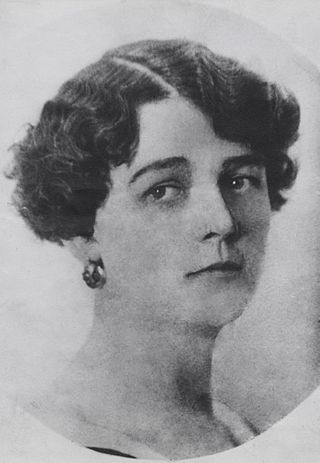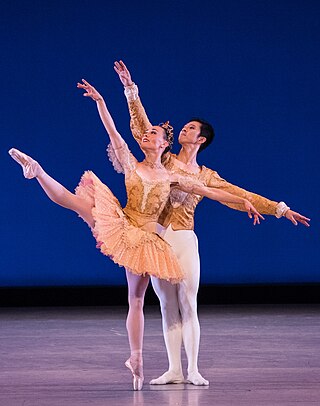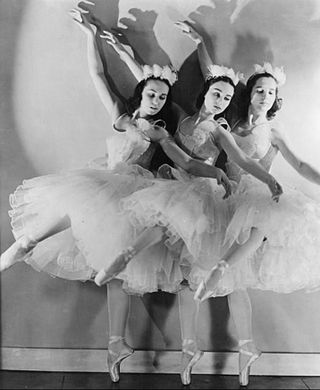
New York City Ballet (NYCB) is a ballet company founded in 1948 by choreographer George Balanchine and Lincoln Kirstein. Balanchine and Jerome Robbins are considered the founding choreographers of the company. Léon Barzin was the company's first music director. City Ballet grew out of earlier troupes: the Producing Company of the School of American Ballet, 1934; the American Ballet, 1935, and Ballet Caravan, 1936, which merged into American Ballet Caravan, 1941; and directly from the Ballet Society, 1946.

Lincoln Edward Kirstein was an American writer, impresario, art connoisseur, philanthropist, and cultural figure in New York City, noted especially as co-founder of the New York City Ballet. He developed and sustained the company with his organizing ability and fundraising for more than four decades, serving as the company's general director from 1946 to 1989. According to the New York Times, he was "an expert in many fields", organizing art exhibits and lecture tours in the same years.

Varvara Jmoudsky, better known as Barbara Karinska or simply Karinska, was the Oscar-winning costumier of cinema, ballet, musical and dramatic theatre, lyric opera and ice spectacles. Over her 50-year career, that began at age 41, Karinska earned legendary status time and again through her continuing collaborations with stage designers including Christian Bérard, André Derain, Irene Sharaff, Raoul Pêne du Bois and Cecil Beaton; performer-producers Louis Jouvet and Sonja Henie; ballet producers René Blum, Colonel de Basil and Serge Denham. Her longest and most renown collaboration was with choreographer George Balanchine for more than seventy ballets — the first known to be “The Celebrated Popoff Porcelain,” a one act ballet for Nikita Balieff's 1929 La Chauve-Souris with music by Tchaikovsky for which Karinska executed the costumes design by Sergey Tchekhonin. She began to design costumes for Balanchine ballets in 1949 with Emmanuel Chabrier's “Bourrèe Fantasque,” for the newly founded New York City Ballet. Their final collaboration was the 1977 "Vienna Waltzes.” Balanchine and Karinska together developed the American tutu ballet costume[9] which became an international costume standard.
Jewels is a three-act ballet created for the New York City Ballet by co-founder and founding choreographer George Balanchine. It premièred on Thursday, 13 April 1967 at the New York State Theater, with sets designed by Peter Harvey and lighting by Ronald Bates.

Stars and Stripes is a neoclassical ballet choreographed by George Balanchine to music by John Philip Sousa, orchestrated by Hershy Kay. The ballet was made as a tribute to the United States, Balanchine's adopted country. It premiered on January 17, 1958, at the City Center of Music and Drama, danced by the New York City Ballet. It is dedicated to Fiorello La Guardia, former mayor of New York City. The ballet had been revived by multiple ballet companies, and at different special occasions.

Theme and Variations is a ballet choreographed by George Balanchine to the final movement of Tchaikovsky's Orchestral Suite No. 3. The ballet was made for Ballet Theatre, and premiered on November 26, 1947, at the City Center 55 Street Theater, with the two leads danced by Alicia Alonso and Igor Youskevitch.
Symphony in C, originally titled Le Palais de Cristal, is a ballet choreographed by George Balanchine, to Georges Bizet's Symphony in C. The ballet was originally created for the Paris Opera Ballet, and premiered on July 28, 1947 at Théâtre National de l'Opéra.

Episodes is a ballet choreographed by Martha Graham and George Balanchine, to compositions by Anton Webern. The ballet was a co-production between the Martha Graham Dance Company and Balanchine's New York City Ballet (NYCB). Though it was conceived to be a collaboration between Graham and Balanchine, leading choreographers in modern dance and neoclassical ballet respectively, they ultimately worked separately on the ballet's two halves. Episodes I was choreographed by Graham, for dancers from her company and four NYCB members, and depicts Mary, Queen of Scots remembering the events in her life before her execution. Episodes II, by Balanchine, is completely plotless, and made for members of the NYCB and Graham dancer Paul Taylor, who originated a solo. The ballet uses all seven orchestral compositions by Webern.
Orpheus is a thirty-minute neoclassical ballet in three tableaux composed by Igor Stravinsky in collaboration with choreographer George Balanchine in Hollywood, California in 1947. The work was commissioned by the Ballet Society, which Balanchine founded together with Lincoln Kirstein and of which he was Artistic Director. Sets and costumes were created by Isamu Noguchi.
Lewellyn Farr Christensen was a ballet dancer, choreographer and director for many companies. He was largely associated with George Balanchine and the San Francisco Ballet, which he directed from 1952–1984. Other companies Christensen was a part of include Ballet Caravan, directed by Lincoln Kirstein, and Ballet Society, directed by Kirstein and Balanchine.
Barbara Anne Milberg Fisher was an American academic and professional dancer. She was professor emerita of English at the City College of the City University of New York (CUNY), where she taught for 29 years. She published several works, including on the life of Wallace Stevens. Prior to her academic career, under her maiden name, Barbara Milberg, she danced with the short-lived Ballet Society, founded by George Balanchine and Lincoln Kirstein; became soloist with the New York City Ballet (NYCB) in its first decade; and then joined Jerome Robbins's newly formed Ballets: USA, touring Europe and the States with that company as a principal dancer.
Bugaku is a ballet made by New York City Ballet co-founder and ballet master George Balanchine to eponymous music by Toshiro Mayuzumi, commissioned by City Ballet in 1962. The premiere took place on 30 March 1963 at City Center of Music and Drama, New York, with scenery by David Hays, costumes by Karinska, and lighting by Ronald Bates. NYCB had toured Japan in 1958 and the Gagaku Company of the Imperial Household toured the US the following year.
Tschaikovsky Piano Concerto No. 2, also titled Ballet Imperial, is a ballet choreographed by George Balanchine to Tchaikovsky's Piano Concerto No. 2. Ballet Imperial was choreographed for American Ballet Caravan's 1941 South American tour, and was aimed at showing that the Americans were capable of the classical ballet traditions. The ballet pays tribute to Tchaikovsky, the classical ballet choreographer Marius Petipa, and Imperial Saint Petersburg, where Balanchine received his ballet training. The ballet featured academic steps and alludes to Imperial Russia through the costumes and scenery. Ballet Imperial premiered on June 25, 1941, at Teatro Municipal, Rio de Janeiro.
Ronald Bates was an American ballet lighting designer, particularly for the New York City Ballet.
Choreographer George Balanchine's production of Petipa and Tchaikovsky's 1892 ballet The Nutcracker is a broadly popular version of the ballet often performed in the United States. Conceived for the New York City Ballet, its premiere took place on February 2, 1954, at City Center, New York, with costumes by Karinska, sets by Horace Armistead and lighting and production by Jean Rosenthal.

Olga Elise Reiman was an American ballet dancer and dance educator. After starting her career working with choreographer Adolph Bolm, she danced at the American Ballet and Ballet Society, both forerunners of the New York City Ballet, and originated several roles for choreographer George Balanchine. Reiman taught at Balanchine's School of American Ballet between 1945 and 1953 and from 1964 until her death.
Les Ballets 1933 was a ballet company started by Boris Kochno and George Balanchine, which Balanchine used to create new works that were completely his own, set to music that no one had yet choreographed. The company ran for less than four weeks in 1933 and tailored itself to small, wealthy audiences in Paris and London, but despite its scale, it came out with works that Balanchine later used to instruct at his School of American Ballet, and in the programs of his later companies. Outside a theatre for Les Ballets, Balanchine first met Lincoln Kirstein.
Balanchine technique or Balanchine method is the ballet performance style invented by dancer, choreographer, and teacher George Balanchine (1904–1983), and a trademark of the George Balanchine Foundation. It is used widely today in many of Balanchine's choreographic works. It is employed by ballet companies and taught in schools throughout North America, including the New York City Ballet and School of American Ballet, where it first emerged.

Ruthanna Boris was the first American Ballerina to star with the Ballet Russe de Monte Carlo troupes of the 1940s. She was born in Brooklyn. She was among the first students at George Balanchine and Lincoln Kirstein’s School of American Ballet when it opened in 1934. As a choreographer her ballets Cirque de Deux and Cakewalk, are often revived. She died in El Cerrito, California and her papers are held at Houghton Library, Harvard University.
Divertimento No. 15 is a ballet choreographed by George Balanchine to Mozart's eponymous music. The ballet was made for the New York City Ballet. Balanchine first choreographed the score in 1952, for a ballet titled Caracole. In 1956, he planned to revive Caracole for a celebration of Mozart's bicentenary but made a new ballet to the same music instead. Divertimento No. 15 premiered on May 31, 1956, at the American Shakespeare Theatre, Stratford, Connecticut.







